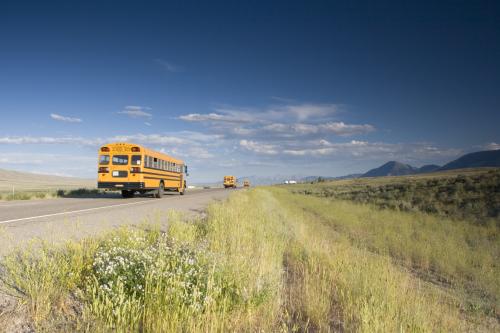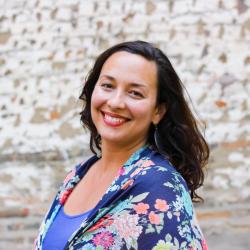This post is part of the “Community Schools Leader Insights” series in which Brookings is sharing the experiences of people in the thick of community schools and who are making strides toward student success through the unique strengths of the local community.
Rosenwald Schools: A blueprint for community schools in the Deep South
Community school strategies are starting to flourish in the Deep South, jumpstarting a powerful, equitable, and community-informed educational approach that lays the foundation for teaching and learning. The basis for community schools in the South has historic roots that offer ways to practice democracy and build a shared future in the present day.
Sara Sneed, president and CEO of the NEA Foundation, says that some of the first community schools in the U.S. came in the form of Rosenwald Schools of the South. These were community-driven, high-quality schools that served more than one-third of African-American children across the South by 1928—initiated by Booker T. Washington of the Tuskegee Institute and Julius Rosenwald, philanthropist and president of Sears Roebuck. The legacy of these schools influences how education leaders like Sneed are bringing communities together for educational opportunities for residents of the Deep South, and particularly to improve access and education justice for Black children.
Community schools in the Deep South are making space for people to co-create that future by building relationships, trust, and authentic communication.
Today, over one-third of all K-12 students and 56 percent of Black children reside in the South. Meanwhile, education spending per pupil, teacher salaries, college matriculation and completion rates, and math and reading scores are typically below national averages in most southern states. Despite all this being true, only 3 percent of philanthropic investment nation-wide is directed towards the South.
A Southern Regional Alliance for Community Schools emerges through quarterly convenings
Today, education leaders are working to address these educational conditions that persist throughout the Deep South through community school strategies. The NEA Foundation has made preliminary investments in Arkansas, Louisiana, and Mississippi community schools with quarterly convenings for grantees, who have named themselves the “Southern Regional Alliance for Community Schools.” Sneed sees this investment as a way for philanthropies to demonstrate what is truly valued and supported when it comes to equity in education.
The NEA Foundation has a four-pronged approach to supporting community schools in Arkansas, Louisiana, and Mississippi: grants, technical assistance, convenings, and policy change. They make grants that begin with year-long planning—focusing on building relationships that go deep rather than wide—which is why they have grantees in three target states.
When the NEA Foundation launched their Community Schools Initiative (CSI) in 2020, following more than a year of preplanning with people and organizations throughout the region and nationally, to the best of their knowledge there were no community schools in Arkansas or Mississippi, and only one in Louisiana. There are now 16 established and formally named community schools; 13 schools that are under development or slated for transformation into community schools; and seven school districts at a visioning stage that have expressed interest or are developing the community schools strategy. According to Sneed, “Ample research points to up to $15 in social value and economic benefit for every dollar spent in developing a community school.”
The Foundation sets up grantees with technical assistance and coaching that is not prescriptive, so each site can pursue its self-determined priorities and preferred courses of action. The set goals for grantees are to establish or expand a team or coalition to develop strategy and deepen that team’s understanding of community schools strategies; conduct local needs and interests assessments and an environmental scan to assess capacity; and create a work plan for implementation of the community school(s). Hands-on support comes from the Institute for Educational Leadership Coalition for Community Schools, Harvard Graduate School of Education’s EdRedesign Lab, FourPoint Education Partners, and others.
State and local policies can also create the conditions that enable partners or services, such as school-based health centers, to operate in schools. Consequently, the NEA Foundation partners with local, state, and federal actors to create policies related to financing, implementing, and/or securing technical support for community schools.
Career pathways are made real through community school partnerships in Arkansas.
Far from community school strategies focusing purely on resource provision, or “wraparound services,” Sneed prioritizes instruction: “Community schools are first and foremost schools, so focusing on the instructional core is key. Services can’t compensate for that core, they can only enhance that. We know that co-location of resources in schools can have benefits, but it’s only when they are aligned into a comprehensive and synergistic whole towards clearly defined goals that you begin to see impact and advancement.”
For example, the Batesville School District in Arkansas is collaborating with a local manufacturing business to create an engineering pathway for high school students. Laura Howard, the district’s lead and coordinator for community school strategies and an educator of 32 years, says, “Community schools strategies offer innovative ways of connecting with local businesses to create immersive experiences so students can take what they have learned in their class and apply it to real world situations with actual engineers.”
When Howard does professional development training for districts that are considering community schools strategies, she often tells them that they may be implementing some aspects of the strategy already, but the framework is helpful for understanding best practices and creating ways to innovate that put students first. She says, “Community schools strategies put students first.” But that doesn’t mean that the strategy is the same from district to district. Howard also says, “If you’ve seen one community school, you’ve seen one community school. Each one is different.”
Community schools in the South offer a way to practice democracy and build a shared future
The practice of building trust and partnership takes a lot of time and patience in the process of growing community school strategies. In the Deep South, complex power dynamics exist between institutions like education and community-based organizations. But community school leaders have seen the benefits outweigh the obstacles time and time again, not just for individual students, but for their future contributions to the well-being of their communities and society as a whole.
Senator Robert L Jackson, CEO of Quitman County Development Organization, Inc. has described how Quitman County’s residents, school leaders, nonprofit and faith-based organizations, and others readily came to the table to explore and implement the community school strategy together under the leadership of its superintendent, Dr. Fredrick Robinson. They were able to do this through what he describes as a “democratic process” in which all voices are genuinely honored and respected.
Jackson says, “Cultivating community schools creates new opportunities, not only for communities to determine what each wants for itself, for its children, and others, it relies on those essential commitments that advance democracy – everyone contributing their best critical thinking, sense of self-efficacy, and the desire to participate in decisionmaking processes that directly and indirectly affect everyone.”
Sneed says, “The community school strategy offers so many benefits, from academic to social and emotional well-being, but also allows us a way to practice the idea of democracy because they offer a pragmatic, focused way for people in communities to come together and imagine a future together.” Community schools in the Deep South are making space for people to co-create that future by building relationships, trust, and authentic communication.
The Brookings Institution is committed to quality, independence, and impact.
We are supported by a diverse array of funders. In line with our values and policies, each Brookings publication represents the sole views of its author(s).








Commentary
3 states in the Deep South are collaborating to advance community schools
December 21, 2022